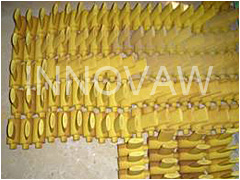permanent mold casting

Permanent mold castings, while not as flexible as sand castings in allowing the use of different patterns (different part designs), lower the cost of producing a part. At a production run of 1000 or more parts, permanent mold castings produce a lower piece cost part. Of course, the break-even point depends on the complexity of the part. More complex parts being favored by the use of permanent molds.
The usual considerations of minimum wall thicknesses (such as 3mm for lengths under 75 mm), radius (inside radius = nominal wall thickness, outside radius = 3 x nominal wall thickness), draft angles (1 to 3?on outside surfaces, 2 to 5on inside surfaces) etc all apply. Typical tolerances are 2 % of linear dimensions. .
Typical part sizes range from 50 g to 70 kg (1.5 ounces to 150 lb). Typical materials used are small and medium sized parts made from aluminum, magnesium and brass and their alloys. Typical parts include gears, splines, wheels, gear housings, pipefittings, fuel injection housings, and automotive engine pistons.
Other Permanent Mold Castings
Slush Casting: Slush Casting is a special type of permanent mold casting, where the molten metal is not allowed to completely solidify. After the desired wall thickness is obtained, the not yet solidified molten metal is poured out. This is useful for making hollow ornamental objects such as candlesticks, lamps, statues etc.
Corthias Casting: Corthias Casting is another variation of the permanent mold casting, where a plunger is used to pack down the molten metal form the sprue hole. This allows for thinner walls and greater details to be produced.
Low Pressure Permanent Mold Casting: Low Pressure Permanent Mold Casting is yet another variation of the permanent mold casting. Here, instead of using gravity to assist in the metal pour and flow in the mold, a low pressure of upto 1 atmosphere gas is applied to the molten metal. This maintenance of pressure on the melt causes complete fill of the mold and compensates for any shrinkage on cooling. Thin wall castings can be made. Mechanical properties are about 5 % superior to permanent mold casting. Since no riser is used (unlike a regular casting), the yield is generally higher since the metal in the pressurized feed tube is still molten and the mold is ready for the next shot right away.
Vacuum Permanent Mold Casting
Vacuum Permanent Mold Casting is yet another variation of the permanent mold casting. This is similar to the low-pressure permanent mold casting, where a vacuum is used instead of a pressure. Thin wall castings can be made as in the low-pressure permanent mold casting. In addition, the yields are high since no risers are used. Since vacuum is used instead, the purity of the metal is maintained. The mechanical properties of the casting are 10 to 15 % superior to the traditional permanent mold casting. Castings range in size from 200 g to 4.5 kg (6 oz to 10 lb).
If you wanted to know more about permanent mold casting ,Please visit our Website:http://www.nbdiecasting.com
